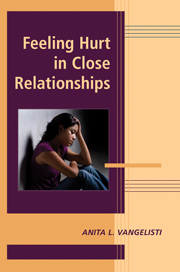Book contents
- Frontmatter
- Contents
- List of Contributors
- Foreword
- PART I INTRODUCTION
- PART II CONCEPTUALIZING HURT
- 2 The Nature of Hurt Feelings: Emotional Experience and Cognitive Appraisals
- 3 Thinking the Unthinkable: Cognitive Appraisals and Hurt Feelings
- 4 Adding Insult to Injury: The Contributions of Politeness Theory to Understanding Hurt Feelings in Close Relationships
- 5 Rejection Sensitivity: A Model of How Individual Difference Factors Affect the Experience of Hurt Feelings in Conflict and Support
- 6 Understanding and Altering Hurt Feelings: An Attachment-Theoretical Perspective on the Generation and Regulation of Emotions
- PART III HURTFUL ACTS
- PART IV HURT IN RELATIONAL CONTEXTS
- PART V HURT IN APPLIED CONTEXTS
- Author Index
- Subject Index
- References
2 - The Nature of Hurt Feelings: Emotional Experience and Cognitive Appraisals
from PART II - CONCEPTUALIZING HURT
Published online by Cambridge University Press: 04 August 2010
- Frontmatter
- Contents
- List of Contributors
- Foreword
- PART I INTRODUCTION
- PART II CONCEPTUALIZING HURT
- 2 The Nature of Hurt Feelings: Emotional Experience and Cognitive Appraisals
- 3 Thinking the Unthinkable: Cognitive Appraisals and Hurt Feelings
- 4 Adding Insult to Injury: The Contributions of Politeness Theory to Understanding Hurt Feelings in Close Relationships
- 5 Rejection Sensitivity: A Model of How Individual Difference Factors Affect the Experience of Hurt Feelings in Conflict and Support
- 6 Understanding and Altering Hurt Feelings: An Attachment-Theoretical Perspective on the Generation and Regulation of Emotions
- PART III HURTFUL ACTS
- PART IV HURT IN RELATIONAL CONTEXTS
- PART V HURT IN APPLIED CONTEXTS
- Author Index
- Subject Index
- References
Summary
A prevailing question in the study of emotion has involved the number and identity of human emotions. Theorists have sliced the emotional pie in a variety of ways, but most fall into one of two camps. Advocates of categorical approaches have identified a relatively small number of “basic” emotions – such as anger, fear, joy, sadness, disgust, and surprise – that cannot be reduced to other, more fundamental states (e.g., Ekman, 1992; Izard, 1991; Plutchik, 1980; Tomkins, 1962). These theorists suggest that all emotional experiences can be defined as mixes, blends, or hybrids of these basic emotions.
In contrast, proponents of dimensional models have argued that emotions are not divisible into discrete units. Rather, they suggest that much of the variance in emotional experience can be captured by a small number of primary dimensions. Some theorists endorse two-dimensional models characterized by the valence of the emotion (pleasant vs. unpleasant) and the degree of arousal or activation involved (aroused vs. tranquil; see Larsen & Diener, 1992; Russell, 1980; Watson & Tellegen, 1985). Others suggest that the data are better explained by a three-dimensional model defined by dimensions of valence, potency, and activity (Shaver, Schwartz, Kirson, & O'Conner, 1987).
- Type
- Chapter
- Information
- Feeling Hurt in Close Relationships , pp. 15 - 33Publisher: Cambridge University PressPrint publication year: 2009
References
- 28
- Cited by

